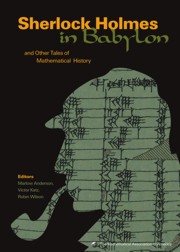Book contents
- Frontmatter
- Introduction
- Contents
- Ancient Mathematics
- Medieval and Renaissance Mathematics
- Foreword
- The Discovery of the Series Formula for π by Leibniz, Gregory and Nilakantha
- Ideas of Calculus in Islam and India
- Was Calculus Invented in India?
- An Early Iterative Method for the Determination of sin 1°
- Leonardo of Pisa and his Liber Quadratorum
- The Algorists vs. the Abacists: An Ancient Controversy on the Use of Calculators
- Sidelights on the Cardan-Tartaglia Controversy
- Reading Bombelli's χ-purgated Algebra
- The First Work on Mathematics Printed in the New World
- Afterword
- The Seventeenth Century
- The Eighteenth Century
- Index
- About the Editors
An Early Iterative Method for the Determination of sin 1°
from Medieval and Renaissance Mathematics
- Frontmatter
- Introduction
- Contents
- Ancient Mathematics
- Medieval and Renaissance Mathematics
- Foreword
- The Discovery of the Series Formula for π by Leibniz, Gregory and Nilakantha
- Ideas of Calculus in Islam and India
- Was Calculus Invented in India?
- An Early Iterative Method for the Determination of sin 1°
- Leonardo of Pisa and his Liber Quadratorum
- The Algorists vs. the Abacists: An Ancient Controversy on the Use of Calculators
- Sidelights on the Cardan-Tartaglia Controversy
- Reading Bombelli's χ-purgated Algebra
- The First Work on Mathematics Printed in the New World
- Afterword
- The Seventeenth Century
- The Eighteenth Century
- Index
- About the Editors
Summary
Background
In his popular History of Mathematics, Carl B. Boyer [5] dated the medieval period in Europe from 529 A.D. to 1436. It was in 529 that the Byzantine emperor Justinian, fearing a threat to orthodox Christianity, ordered all pagan philosophical schools at Athens to be closed and the scholars dispersed. Rome, then ruled by the Goths, was hardly a hospitable home for the learned, but many found a haven in Sassanide Persia. To Boyer the year 1436 marked the dawn of a new mathematical era in Christian Europe for two reasons. It saw the birth of the most influential European mathematician of the fifteenth century, Johann Mueller, better known as Regiomontanus, and Boyer took 1436 as the probable year of death of al-Kashi, the last in a long lineage of prominent Muslim scholars (who actually died in 1429).
Until recently, historical accounts esteemed Muslim scientists mainly for holding Greek learning in cold storage until Europe was ready to accept it, and indeed the decline of Muslim scholarship did coincide with Europe's emergence from the Middle Ages. But between 750 and 1450, Islamic civilization in fact produced a series of remark-able mathematicians who, among other accomplishments, invented the decimal system (including decimal fractions), created algebra, systematized plane and spherical trigonometry, made important discoveries in these sciences, and developed ingenious methods for solving algebraic equations. Only recently have researchers in the history of mathematics begun to re-discover what medieval and renaissance scholars knew well, the intellectual legacy bequeathed by Muslim scientists.
- Type
- Chapter
- Information
- Sherlock Holmes in BabylonAnd Other Tales of Mathematical History, pp. 138 - 142Publisher: Mathematical Association of AmericaPrint publication year: 2003



